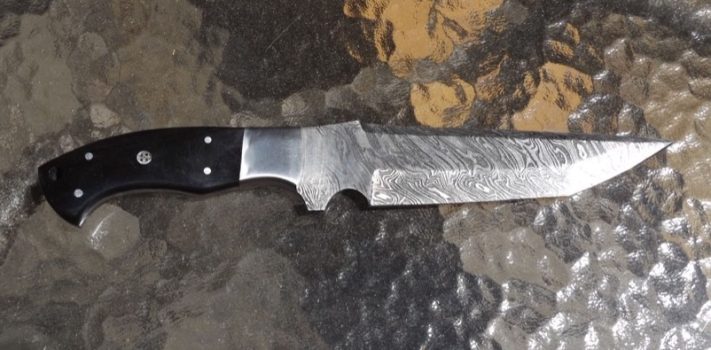Today, I’m going to cover something a little bit different in the cutlery world. it is a nice fixed-blade fighting knife, made in Pakistan out of Damascus steel, and marketed by Valley Forge Cutlery. Damascus steel-bladed knives used to be all the rage and it was pretty much restricted to the custom knife-makers’ realm. First, a little bit of history is called for:
Damascus steel-bladed knives go back to Damascus, Syria some centuries ago. The development of this steel began perhaps as early as 700 AD, but most point to closer to 900 AD. But “authoritative” sources vary widely. Most modern Damascus steel knives are made out of 1095 carbon steel, with a little bit of chrome mixed in. What is involved in a Damascus blade is a forging process. The steel is heated – red hot – and then pounded. This used to be done by hand, but today it is a little bit easier with automated trip-hammers. When the steel is pounded, it is then folded over onto itself, and the process starts all over again. Some Damascus blades had folded over on themselves hundreds of times during this process. The knife under review here has about 200 layers – and that is more than sufficient to give the steel added strength.
In the past, some custom knife makers boasted that their blades had 500 or more layers before it was shaped. I don’t know if that makes the blade any stronger or not. In the past, a Damascus steel blade would run you about $100 per inch – and that’s a lot of money. I once had a folding pocket knife that boasted 500 layers of steel – I didn’t see that is was any stronger than other blades, so take it for what it is worth.
The Damascus blade under review today came from Cutlery Corner and that might raise some red flags. If you have watched their infomercials on television, then you will recognize this style knife. Many, but not all of their knives are rather inexpensive and the poor quality shows. However, they do offer some really good knives at bargain prices. So, buyer beware!
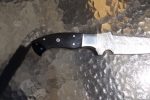 The model I ordered was only about $50. That is quite a deal, and I wasn’t expecting much for my money. I was pleasantly surprised at the quality of this fighter. It was made in Pakistan, and they are turning out some great knives these days, at bargain prices. This one is marked “Valley Forge” and has a stock number VFD-76B/H. I couldn’t find any flaws in the knife.
The model I ordered was only about $50. That is quite a deal, and I wasn’t expecting much for my money. I was pleasantly surprised at the quality of this fighter. It was made in Pakistan, and they are turning out some great knives these days, at bargain prices. This one is marked “Valley Forge” and has a stock number VFD-76B/H. I couldn’t find any flaws in the knife.
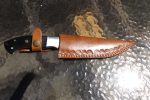 With a blade slightly over 6-inches long, and an overall length of 13-inches, it is quite a fixed blade. The bolster is stainless steel, and the pins are also stainless. The handle is made out of buffalo horn, it is dark brown/black in color. It is a full-tang fixed blade – that means the blade goes all the way through the handle. A nice leather sheath comes with this knife – not the best, but it is still a decent sheath.
With a blade slightly over 6-inches long, and an overall length of 13-inches, it is quite a fixed blade. The bolster is stainless steel, and the pins are also stainless. The handle is made out of buffalo horn, it is dark brown/black in color. It is a full-tang fixed blade – that means the blade goes all the way through the handle. A nice leather sheath comes with this knife – not the best, but it is still a decent sheath.
A word about Damascus steel blades – and take it as a law: NEVER store a Damascus steel blade in the sheath. If you do, you will find that it rusts in very short order. ALWAYS keep a coat of some kind of oil on the blade, to help retard rusting. I used Barricade – and I used it on all my knives – even stainless steel blades – and all my firearms – to make sure they don’t rust. It only takes a little bit of Barricade on a patch. Wipe the gun or knife down, and it will surely help your knife or gun from rusting. That is cheap insurance!
This fixed blade knife came fairly sharp, right out of the box, but not as sharp as I’d like – so a few minutes on a set of croc sticks had it razor sharp. During all my testing I never once had to touch up the blade’s edge. Damascus steel holds an edge a good long time, and is easier to touch up than stainless steel blades are.
There is a handy lanyard hole in the butt of the knife. No lanyard came with it. However, a piece of 550 para cord will work nicely.
When it comes to Damascus steel blades, they can be made in all manner of patterns, and no two are exactly alike. So, be aware, if you order one of these knives – what you get will be different from the pattern that I received.
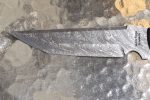 So, how do they manage to produce Damascus steel knives so affordable in Pakistan? Well, they don’t manually hammer the blades, and fold the steel over on itself. Instead they use hydraulic hammers – once the blade steel is heated up, it is hammered over on itself, and then heated up all over again, and the steel is hammered over onto itself again and again. This is still a very time-consuming process. Buf this was done by hand – the hammering and folding – over and over again, then this knife would easily cost $600, or more.
So, how do they manage to produce Damascus steel knives so affordable in Pakistan? Well, they don’t manually hammer the blades, and fold the steel over on itself. Instead they use hydraulic hammers – once the blade steel is heated up, it is hammered over on itself, and then heated up all over again, and the steel is hammered over onto itself again and again. This is still a very time-consuming process. Buf this was done by hand – the hammering and folding – over and over again, then this knife would easily cost $600, or more.
This isn’t a “camp” knife per se. Instead, it is meant to be a weapon – and it will defend you nicely if you have to use it – a well-made blade, with a great edge on it will easily but off an arm or a leg without much trouble. You could, in a pinch, use this as a hunting knife – but be advised that the blood from the livestock or wild game will easily stain the Damascus look.
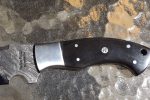 During my testing, I was down with the Covid, and couldn’t get all my regular testing in, since I was severely weakened. Still, I managed some “abusive” testing…the knife easily sliced through everything I threw at it – and I did my best to damage the blade – didn’t happen. It was no chore to cut through 1-inch hemp rope with a single swipe. The blade was scary sharp and I used a lot of caution with cutting material. After each use, I cleaned the blade and gave it a good coat of Barricade to help prevent any rust from starting.
During my testing, I was down with the Covid, and couldn’t get all my regular testing in, since I was severely weakened. Still, I managed some “abusive” testing…the knife easily sliced through everything I threw at it – and I did my best to damage the blade – didn’t happen. It was no chore to cut through 1-inch hemp rope with a single swipe. The blade was scary sharp and I used a lot of caution with cutting material. After each use, I cleaned the blade and gave it a good coat of Barricade to help prevent any rust from starting.
If you’re in the market for an old-fashioned Damascus blade knife, then this would make an excellent end of the world knife. And even if the blade picks up some rust, it won’t affect the usefulness of the knife. It’s really not that big of a task to wipe the blade dry and add some oil or Barricade on it.
Damascus steel knives are known for their strength, and this sample was no slouch – it will do all that you want it to – and with a little bit of care, it will last you a lifetime. Plus, if you know someone who is into collecting knives, this would make a great present for them – and they’ll believe you spent hundreds of dollars for it.
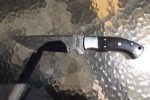 Just use caution when buying a knife online from Cutlery Corner – I’m not saying that all of their knives are “junk” but a lot of them are. When they advertise 150 knives for a little bit of money, you can be sure many of the folders have plastic handles and don’t come sharp – nor can you sharpen them. I do resent that they refer to many fixed blade knives as “Bowie” knives – never saw one – I’ve seen some Bowies knives over the years, then again, Cutlery Corner has several hosts that are from the “south” and to them, every big knife is called a “Bowie”, for some reason.
Just use caution when buying a knife online from Cutlery Corner – I’m not saying that all of their knives are “junk” but a lot of them are. When they advertise 150 knives for a little bit of money, you can be sure many of the folders have plastic handles and don’t come sharp – nor can you sharpen them. I do resent that they refer to many fixed blade knives as “Bowie” knives – never saw one – I’ve seen some Bowies knives over the years, then again, Cutlery Corner has several hosts that are from the “south” and to them, every big knife is called a “Bowie”, for some reason.
Cutlery Corner has a great website – more knives you can look at over the course of several days. Of course, many of these cheap knives are made in mainland China so avoid those like the plague…they look good on tv or their website, but they aren’t worth a buck if you ask me. Just my humble opinion – spend your money carefully and do some research before you buy something that sounds to good to be true. A lot of people don’t know the difference between a good knife and one that isn’t good at all.
I used to not only haunt gun shops, but knife stores as well. And, I had never seen a reasonably-priced Damascus blade – from any source, that comes close to the quality of this Valley Forge Damascus steel blade. You can shop online and I don’t think you’ll find anything that matches this Damascus steel blade fixed blade knife, in this price range.
So, why not treat yourself to a quality knife, made out of “ancient” steel – like this one is, I think you’ll be more than a little pleased. And, if a knife you purchase from Cutlery Corner isn’t up to your expectations, you can return it for a full refund if it is returned within 30 days.
I’ll be testing and reporting on another Valley Forge Damascus steel knife in the very near future, so keep checking SurvivalBlog.com for this coming report.

